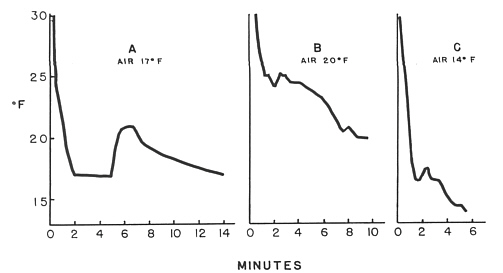QBARS - v19n1 Cold Injury on Hardy Rhododendron
Cold Injury On Hardy Rhododendron
J. R. Havis, University of Massachusetts, Amherst. Mass.
Contribution of the Massachusetts Agricultural Experiment Station, Amherst.
Winter injury on rhododendron does not follow easily explainable patterns or appear according to established hardiness ratings. A number of causes for such injury could be suggested, among them, rapid drop and rapid rise in temperature are frequently mentioned. Such explanations have been mainly guesses, without support from controlled experiments.
In the winter of 1963-64 we had available at Amherst a number of 4 year-old R. catawbiense 'Grandiflorum' plants in 8-inch clay pots in the open, but mulched with shavings.
The cold tolerance of the leaves could be measured in the laboratory by the use of a methanol bath in a large freezer, temperature of which could be controlled within 1° F. Several stoppered plastic tubes containing leaves were inserted in the bath. As the temperature was gradually lowered, samples were removed at predetermined temperatures and thawed slowly. When the rate of freezing and thawing was 5° F per hour, leaves of the hardened test plants in January tolerated about -40° F. We wondered if such thoroughly hardened plants could be readily injured at higher temperatures by rapid freezing or rapid thawing as might occur in nature.
Trials of various rates of freezing detached leaves showed that a fall of 20° (from +30° to +10° F) in 6 to 10 minutes was required to cause injury. This could be accomplished by plunging the tubes with leaves into the bath at 0°.
Since injury could be produced with rapid freezing, it was surprising that thawing from 0° to 32° in 1.5 minutes was not harmful. This speed of thawing was produced by exposure to air at 80° F. Injury resulted from plunging a frozen leaf directly in warm water.
This shows that it is possible to injure hardened leaves by sudden thawing, but this rate of thawing probably would not occur in nature. Certainly, sunshine on frozen leaves in the early morning would not raise the temperature rapidly enough to cause injury, as is often written in garden columns.
Let us then return to injury by rapid freezing and consider if this condition might occur in nature. Small thermocouples were attached to rhododendron leaves out of doors. On bright winter days when the air temperature was near 10°, the leaves were 20° higher. If the leaves were suddenly shaded, the leaves cooled at rates approaching those found to cause injury in the laboratory tests. Some typical freezing curves are shown in Figure 6. It seems quite likely, therefore, that well hardened rhododendron leaves may be injured by sudden freezing after being warmed by the winter sun.

|
|---|
Fig. 6. Freezing curves of rhododendron leaves in cold air when shade was applied. |
Typical symptoms of freezing injury in these studies consisted of blackened areas or entire leaves. Often the leaf center, or the area along veins was most injured.
The injury from rapid freezing in our studies probably was caused by ice formation inside cells. More gradual freezing allows water to move out of cells, and ice crystals develop between cells with resulting mechanical stresses of slow freezing and thawing. stresses. Well hardened tissue is able to tolerate the stresses of slow freezing and thawing.

